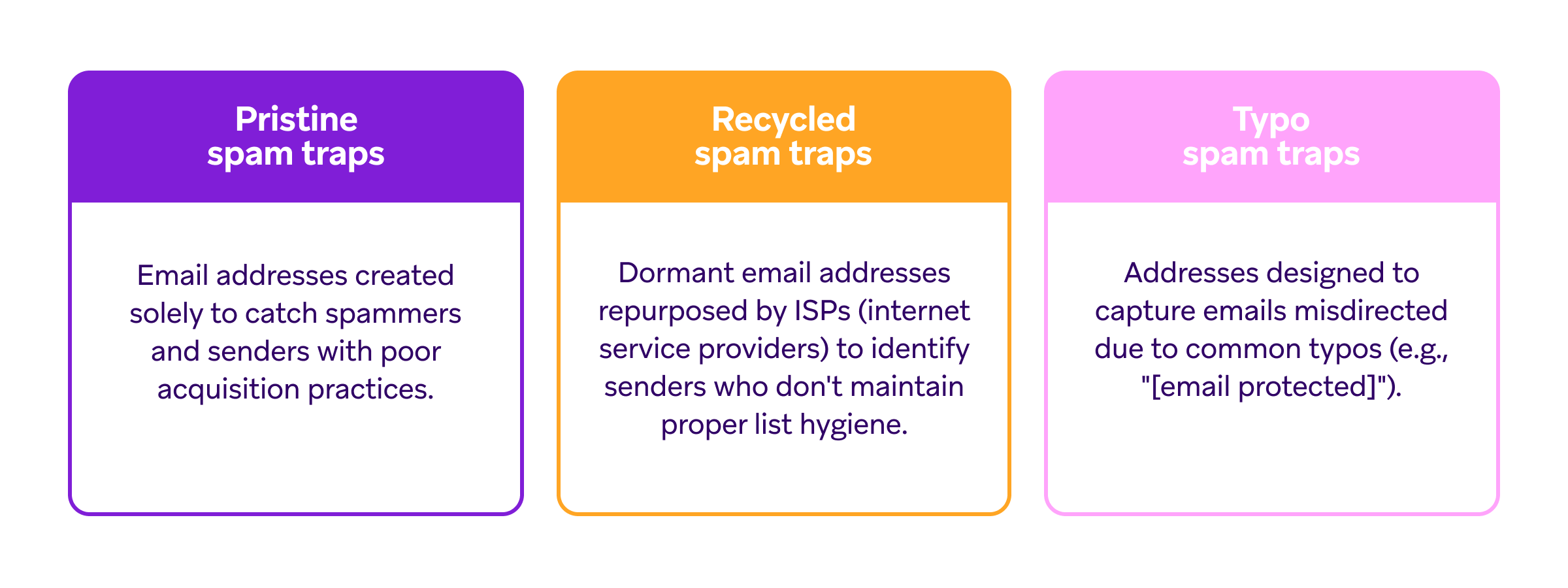Understanding spam traps
Published on April 22, 2025/Last edited on April 22, 2025/13 min read


Pooja Raje
Email Deliverability Principal I, Braze
Dan Stone
Team Lead, Email Deliverability, BrazeNo one wants to fall into a trap right? Not rats, not bears, and definitely not any good email senders. Like the saying goes, a trap is only a trap if you don't know about it. But even if you know about it, it's still a challenge! The good news is, with knowledge comes power.
One of the most dreaded obstacles for email marketers is the infamous spam trap. Let’s dive into the world of spam traps to understand what they really are, the different types, how to prevent them, and much more.
What is a spam trap?
At its core, a spam trap is an email address that is created or used by mailbox providers, blocklist operators, and other anti-spam organizations to identify and catch spammers red-handed.
Alternate terms for spam traps: pristine spam traps, honeypots
Remember the first email address you ever created (which is likely long-abandoned now), a typo you made when providing your email address during sign up, or even an email address you used at a former company (which then became invalid after you embarked on your next adventure)? These dummy, fake, or erroneous email addresses are used as spam traps by mailbox providers (MPs), blocklist operators, anti-spam organizations, etc. to try to identify and catch spammers, who are heedlessly sending emails to these addresses time and again. But often, even legitimate email senders could end up with spam traps in their mailing list if they are not practicing good list hygiene and have poor contact list acquisition techniques.
Sending email to a spam trap is known as ‘hitting a spam trap’ and could prove detrimental to a sender’s email deliverability and sender reputation depending on the type of spam trap being hit and what organization monitors that trap.
The different types of spam traps, and their causes and consequences
Now that we know hitting a trap can impact email performance, it is also important to understand that there are a few different types of spam traps in the email world and that their impact on email deliverability and performance varies significantly. Some spam traps are more damaging to sender reputation than others.
At a high level, there are three main categories of spam traps:
- Pristine spam traps: Email addresses created solely to catch spammers and senders with poor acquisition practices.
- Recycled spam traps: Dormant email addresses repurposed by MPs to identify senders who don't maintain proper list hygiene.
- Typo spam traps: Addresses designed to capture emails misdirected due to common typos (e.g., "[email protected]").
Let’s look at them in more detail and understand the consequences of each of them.

Pristine spam traps
Pristine spam traps are email addresses that are specifically created by MPs, blocklists, and other security organizations with the sole purpose of catching spammers and senders with poor list hygiene. Their only function is to act as a spam trap.
These email addresses have never been valid, and thus are incapable of signing up for an account or opting in to a mailing list. Pristine traps may be added to contact lists during the signup process by app users or site visitors who provide incorrect information to bypass a required form field or get access to gated content without divulging their correct address. The user likely doesn’t realize that they have provided a trap; they have just entered something resembling an email address quickly and without care.
Purchased or rented lists also tend to contain pristine spam traps, as there is no way of validating the authenticity and quality of this purchased data. The only way such traps can enter a sender’s list is if they are collecting data and growing their subscriber list without confirming consent via double opt-in.
Hitting a pristine spam trap is a clear indicator of suspicious data acquisition methods and poor list hygiene practices. It acts as a flag for MPs to identify potentially illegitimate senders and label them as spammers. The consequences of hitting a pristine spam trap are severe and can negatively impact sender reputation. They can cause the sender’s IP address or domain to be added to a blocklist, resulting in emails being rejected or landing in the spam or junk folder. Hence, these spam traps can prove very dangerous for email marketers who are looking to maintain strong email deliverability and a good sender reputation.
Recycled spam traps
Recycled spam traps are email addresses that at one point in time were valid addresses that belonged to real people, but have since been abandoned by their original owners and are no longer in use now (at least not for their original purpose).
Recycled traps help identify senders who are mailing to inactive users frequently and are not cleaning their email list of unengaged recipients. Some examples of recycled spam traps include: defunct domains, personal email addresses that are no longer being used, work email addresses of ex-employees, and college or university email addresses of students who already graduated and moved on.
While senders might have obtained these email addresses by gaining consent initially, if they are sending email campaigns to very old email addresses and contact lists, they could still fall prey to this trap.
Hitting a recycled spam trap is a clear indicator that the sender is not keeping their subscriber lists healthy and up-to-date. That is, the sender is not maintaining their email list by regularly removing inactive users and email addresses, which are bouncing and returning as invalid or have ceased engaging.
What makes recycled spam traps particularly tricky is that they were once valid addresses. That means they may still appear to be legitimate contacts in your database, despite being long-abandoned. Some recycled spam traps may even continue to accept emails without bouncing, making them difficult to detect.
This is why engagement-based segmentation is essential. If a subscriber hasn’t opened or clicked in an extended period, it’s worth investigating whether their email address is still active—or if it has potentially been converted into a spam trap.
While the consequences of hitting recycled spam traps may not be as harmful as pristine spam trap hits, repeatedly sending emails to these addresses can make you look like a spammer, have a negative effect on sender reputation over time, and result in email deliverability issues.
So the next time you want to send re-engagement campaigns to a really old list or an email campaign to your entire database, be careful! Always exercise extreme caution when taking sending risks; trap hits can contribute to blocklistings that severely disrupt your marketing efforts.
Typo spam traps
As the name suggests, typo traps are common typos or misspellings of legitimate domains. These faux addresses make prime targets for trap setters and are designed to ensnare senders with poor list hygiene and data collection practices. Common examples of such typo domains include gnail, hmail, or fmail instead of gmail; hotnail instead of hotmail; yaho instead of yahoo; or ‘.con’ instead of ‘.com’.
Sometimes these invalid addresses could be genuine human errors, but if they are not cleaned off the subscriber list regularly, your reputation may suffer. A typo trap may also be a pristine trap if the domain was created deliberately to discover senders engaging in poor practices.
Hitting a typo trap is an indication that a sender is not incorporating email deliverability best practices, such as double opt-in (or confirmed opt-in) to confirm their subscriber’s email subscription, nor does the sender use email engagement filters for targeting or have a sunset policy in place. These behaviors point towards unhealthy list building and list maintenance practices.
However, it doesn’t necessarily indicate that the sender is a spammer or an illegitimate sender. The consequences of hitting a typo spam trap may not be as severe as a pristine spam trap, but if left ignored could lead to long term email deliverability issues and damage sender reputation over time. After all, prevention is better than cure!
How to find spam trap email addresses and identify spam traps
It’s tricky! A trap is likely indistinguishable from any other email address, and may even engage with your emails, though it will never confirm opt-in. To know if you are hitting spam traps that impact your reputation:
- Monitor your bounces closely and check blocklists. If you are hitting traps at a network or mailbox provider, those providers may add you to their blocklist or reject your mail outright. Blocklist alerting will let you know if your IP or sending domain has been listed. You should also check bounce logs regularly to see if your emails are being rejected or blocked by any providers.
- Some mailbox providers manage their own spam trap networks and have a portal to view this data. An example is Microsoft whose SNDS tool allows senders to view spam trap hits on your IPs. This is only limited to traps that Microsoft has created themselves. Braze customers can access SNDS through the Braze Deliverability Center.
- Utilize a third party deliverability monitoring internet service like Validity who owns an extensive spam trap network and can share the number of traps your IPs or sending domains have hit. These services can also provide the types of traps, the numbers of each type, and sometimes even the specific campaign that triggered the most trap hits.
How to avoid spam traps
Spam traps can silently undermine your email deliverability, making it important to take proactive steps to keep your lists clean and your sender reputation intact. To prevent spam traps from being added to your list, you can do the following:
1. Use double opt-in for better list quality
The easiest way to keep spam traps off your list? Only send emails to people who actually want to hear from you. A double opt-in process—where subscribers confirm their email addresses before receiving messages—helps make sure that your audience is made up of engaged, real users that want to hear from you. This extra step reduces the risk of adding invalid addresses, typo-based spam traps, or bots to your list.
2. Maintain continuous list hygiene
Cleaning your email list once a year isn’t enough—ongoing maintenance is important. Spam traps often show up when marketers hold onto outdated or disengaged contacts for too long. Make list hygiene a regular habit by:
- Removing subscribers who haven’t engaged over a set period
- Running re-engagement campaigns to identify active users before pruning inactive ones
- Scrubbing invalid and bounced addresses from your database
3. Validate email addresses at sign-up
Typos happen—but a simple mistake like entering "yaho.com" instead of "yahoo.com" can lead straight to a spam trap. Email validation tools can help catch errors at the point of collection, reducing the chances of hitting typo-based spam traps and improving the accuracy of your list.
4. Don’t purchase or rent email lists
In addition to violating most ESPs’ Acceptable Use Policies (including our Acceptable Use Policy), you shouldn’t send emails to addresses that haven't actively opted in to your specific brand. Buying a list might seem like a shortcut to faster growth, but it’s also one of the fastest ways to damage your sender reputation.
Aside from policy violation concerns, list vendors often scrape the internet for any addresses they can find to bulk up their lists. Scraped data may contain spam traps and other unsavory data, so avoid purchasing, borrowing, or renting a list even if it’s described as “opt-in”. Focus on growing your list organically through permission-based sign-ups for long-term success.
5. Monitor bounce rates and feedback loops
Spam traps don’t announce themselves—they just quietly impact your ability to reach the inbox. That’s why tracking deliverability metrics is essential. Watch for:
- High bounce rates, which may indicate outdated or trap-laden email lists
- Increased spam complaints, a sign that recipients aren’t expecting or recognizing your emails
- MPfeedback loops, which provide insights into users marking your messages as spam—no need to worry if you are a Braze customer, we set these up on your behalf.
Keeping an eye on these signals helps you spot and address potential spam trap issues before they escalate.
How to remove spam traps
As spam traps are hard to identify, you’ll need to both mitigate and remove them from your data. The best way to suppress possible spam traps from your lists is to use engagement criteria on all sends. In addition to engagement being a critical metric that mailbox providers use to decide where to deliver an email (e.g. the inbox, the spam folder, or to reject the email completely), using engagement metrics such as “has opened” for your campaign sends minimizes the chances of spam traps also being included because a spam trap typically won’t engage with emails. Trap operators like Spamhaus have shared that it is possible, if rare, for traps to engage with mail during their investigations.
It's essential for even legitimate marketers to have a mitigation plan ready to deploy in case of trap-triggered deliverability issues such as impactful blocklistings. If you suspect there are spam traps in your email list, the best action is to suppress them immediately. This will help to minimize the damage to your sender reputation and improve your chances of getting your emails delivered to your subscribers’ inboxes.
Remediation may require lots of segmentation planning; if there are indications that spam traps are on your list, apply strict filters. For example, send only to those who have opened or clicked in the last six months. You must also be prepared to decrease that time frame to three months, or even stricter, if trap hits persist. After you have identified the segment in which spam traps are likely to lurk, you can narrow it down further based on other criteria and send small sends to each segment until you believe you have identified the exact segment containing the spam traps.
Once that segment has been refined, you will want to suppress those addresses, and determine if your list acquisition or management methods require additional improvements to reduce the presence of traps.
In extreme cases, you may need to send a “permission pass” to your list, asking users to click a link to confirm their interest in remaining subscribed. Recipients who click can be retained, but those who do not confirm should be suppressed from further sends.
Moving forward, double opt-in should be performed for all new signups. Traps are, after all, merely a symptom of problematic practices, not a diagnosis.
Key takeaways
Spam traps are a critical aspect of email deliverability. They are created and maintained to catch spam, which may be malicious or simply misdirected marketing mail. Sending emails to spam traps is an indication of poor list hygiene practices such as scraping the web to grow the subscriber list, purchasing lists, infrequent list hygiene, or a lack of proper consent being obtained prior to sending emails. Sending to spam traps can significantly harm your sender reputation and email deliverability, and cause emails to be filtered as spam.
To avoid hitting traps, maintain a clean email subscriber list by regularly removing any inactive or bouncing email addresses. Always gain proper consent from users before adding them to your email list using methods such as double opt-in / confirmed opt-in and monitor results closely. Lastly, do not purchase, trade, or share any email lists, even if a trusted partner offers it to you for free. It’s just not worth the risk.
Spam trap FAQs
Pristine spam traps are fake email addresses created to catch bad senders—they’ve never belonged to a real person. Recycled spam traps were once real but are now inactive, while typo spam traps come from common misspellings of real addresses. Bear in mind that these types may overlap, as a typo could also be pristine.
This usually happens when brands add emails without direct user consent, like using purchased lists, co-registration, or unverified lead sources. If subscribers didn’t actively sign up, spam traps could be lurking in your list. Traps can also be collected during perfectly compliant opt-in processes due to data entry error, unsecured signup forms, or coercive subscription methods.
Spam traps enter lists through fake or high-pressure sign-ups, outdated email addresses, or user typos that aren’t caught. Poor data collection and infrequent list cleaning increase the risk. Potential subscribers should always be given the opportunity to freely opt-into or decline to receive mail, so that their submissions are accurate out of a genuine interest in receiving the mail.
Hitting spam traps hurts sender reputation, lowers email deliverability, and can lead to blocklisting. Over time, this means fewer emails reach real customers, reducing engagement and conversions.
Be Absolutely Engaging.™
Sign up for regular updates from Braze.
Related Content
View the Blog
How behavioral marketing turns data into personalized experiences

Team Braze

Experience optimization: Turning data insights into better journeys

Team Braze

December 2025 Bonfire Marketer of the Month: Jagex’s Emma Oliver
